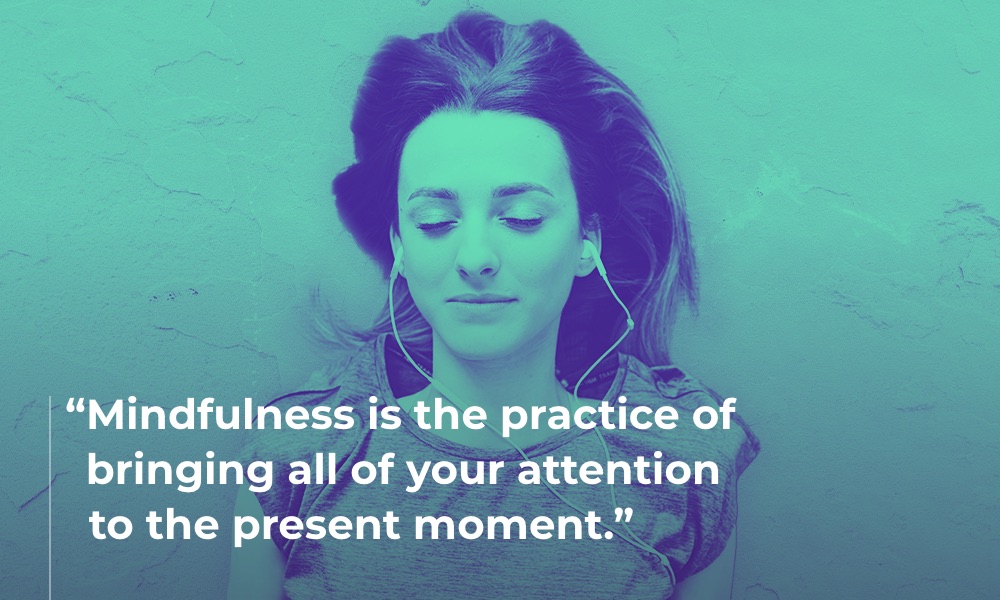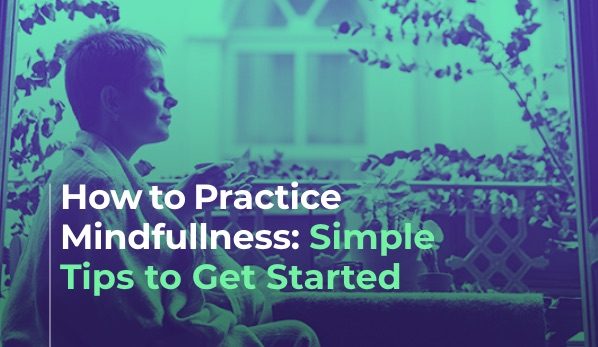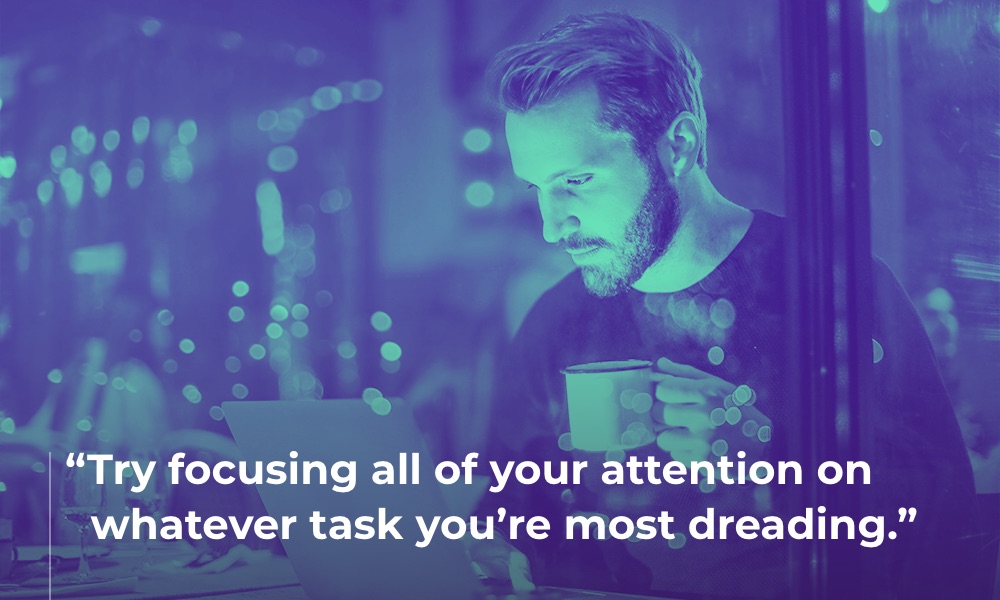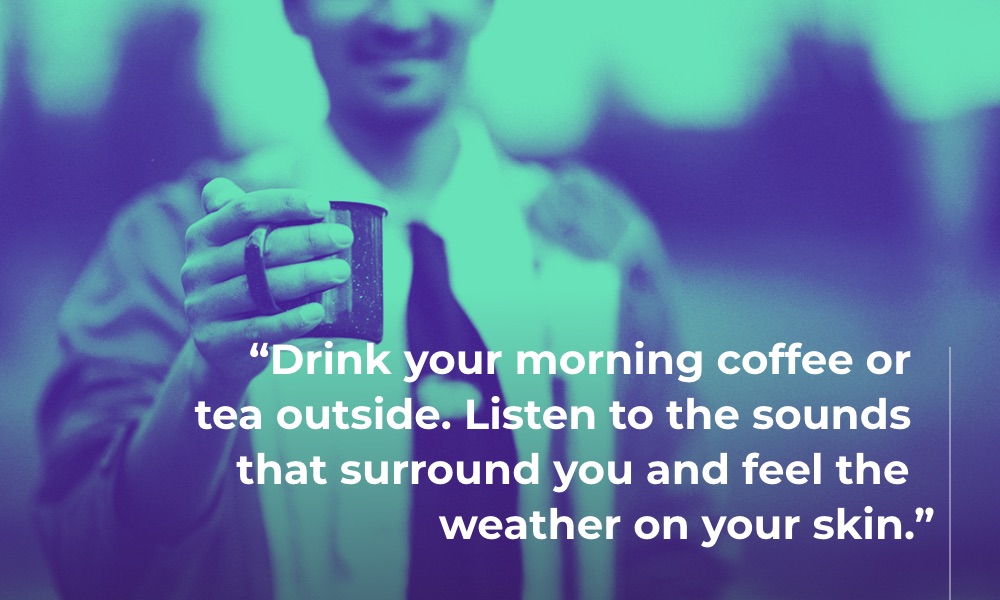Practicing mindfulness is all about tuning into the present moment. You can practice mindfulness by drawing your attention to your senses, developing awareness of your physical sensations, and being more cognizant of your surroundings. Mindfulness is an excellent way to improve your physical and mental health.
This article explores what mindfulness is, how it differs from meditation, and why mindfulness is important. We also share some of the best ways to prepare for practicing mindfulness, along with tips and tricks for how to develop mindfulness. Finally, we let you in on some of our favorite ways to incorporate mindfulness into the day, along with one tip to get started with mindfulness right now. Let’s get started!
What Is Mindfulness?
Mindfulness is the practice of bringing all of your attention to the present moment. This also includes accepting everything that’s happening in the present moment, rather than resisting or ignoring it. Being mindful is one of the best ways to maintain a healthy overall well-being.

You can practice mindfulness in your daily life by turning your full attention to whatever you’re doing, even if it’s just washing the dishes or doing laundry. When you become fully aware of your senses and focus on the present moment, you’re developing your mindfulness.
Mindfulness can also be practiced through specific mindfulness exercises like meditation and mindful breathing. Practicing mindfulness is an excellent way to handle life’s difficult moments with grace and ease. Plus, it can make the good things in life even more enjoyable!
What Is the Difference Between Mindfulness and Meditation?
You may see the terms mindfulness and meditation used interchangeably, but the reality is that they’re not always the same thing.
Just like every square is a rectangle but not every rectangle is a square, every meditation session is a practice in mindfulness, but not every mindfulness practice is a meditation session.
Meditation involves a specific practice, like sitting and focusing on the breath. Meditation is always a form of mindfulness. On the other hand, mindfulness can be practiced while doing anything, even while you’re cleaning your home or making dinner. It’s not a specific exercise, the way meditation is.
Both a meditation practice and a mindfulness practice used throughout the day are great tools for improving your life. They each provide you with slightly different benefits. And when used together, they help you cultivate more presence and calm. They help prepare you for whatever life hands you.
Why Is It Important to Practice Mindfulness?
If just one “secret to life” exists, regularly practicing mindfulness may be it. After all, practicing mindfulness has many positive effects, including helping you be more present.
When you’re more present, you notice all of the tiny pleasures in life that may typically go unnoticed, like truly tasting your first sip of coffee in the morning or really savoring the view of the setting sun on an evening walk.
Over time, this helps you build a richer life and develop more gratitude. And studies show that gratitude is beneficial for your health.
Making mindfulness a daily practice can also reduce the symptoms of anxiety and help prevent burnout. It can help you cope with chronic pain and help you sleep better. Mindfulness is seen as a promising treatment for depression as well.
Plus, the practice of mindfulness can also work as a stress reduction program. It can even improve your relationships! And these are just a few of its many overall wellness and health benefits.
Are you feeling inspired to begin your mindfulness practice? Great! Let’s start with a few tips on how to prepare.
How to Prepare for Practicing Mindfulness
Our number one tip for practicing mindfulness? Have patience with yourself!
For most of us living in the modern world, mindfulness doesn’t come easily—nor were we raised with this practice in mind. We also live in a society that promotes the opposite of mindfulness, where rushing, working, and consumption reign supreme.
Plus, distractions like social media and push notifications are designed to keep us less than mindful. So you’re not going to become a mindfulness expert overnight. And that’s okay! Practicing is the whole point. Your mindfulness skills will grow over time, but don’t judge yourself if you struggle to be mindful at first.
Here’s another important tip: you don’t need any tools to be mindful; you just yourself and your breath. Especially as your interest in mindfulness grows, you may start to feel that you need to purchase items to support your habit.
You may want to buy essential oils, a fancy yoga mat, or a meditation cushion. These things can be nice, but they
absolutely aren’t essential to living a mindful life.
Moreover, don’t feel intimidated by people who are “further along” in their mindfulness journey than you are. You are exactly where you’re supposed to be. Even if you feel like you’re starting a mindfulness practice “too late” in life, keep in mind that it’s much better than not starting it at all.
There are lots of ways to practice mindfulness, and, at first, these mindfulness techniques may seem overwhelming.
But mindfulness does not have to be complicated. When in doubt, just tune into your surroundings. Note the sights, sounds, smells, and tactile sensations that you encounter. Becoming aware of yourself and your surroundings is one of the simplest and most effective ways to practice mindfulness!
How to Practice Mindfulness
There are many ways to practice mindfulness, but a simple way is to do a mindfulness meditation session. To do this Buddhism-rooted practice, start by sitting in a quiet place free of distractions. Turn off any distracting devices, and ask those around you to remain quiet or lower their voices for the duration of their meditation session. Or, if you can, meditate when there are no people around!
Next, draw your attention to your body. Starting at your toes, notice any bodily sensations you feel. There’s no need to judge anything that arises. Simply observe it and then let go. From there, move on to your ankles and do the same thing. Do this with each body part all the way up to the top of your head.
After you’ve completed your body scan meditation, draw your attention to your breath. Focus your attention on each inhale and each exhale. When your mind wanders, simply acknowledge your thoughts and then return back to your breath.
And that’s it! You’ve just practiced mindfulness meditation—pretty simple, huh? Your blood pressure is probably dropping already.
Remember that it’s normal to have a wandering mind or for concentration to be difficult, especially when first starting this practice. But keep at it! Your mindfulness skills will improve over time.
Mindfulness Tips and Tricks
How you choose to practice mindfulness training is up to you. But here are a few tips you can incorporate no matter how you practice:
- Single task: Only do one thing at a time. Trying to focus on multiple tasks simultaneously (like answering an email while speaking on the phone) undermines the goals of mindfulness and amplifies stress.
- Don’t rush: Move as slowly as the slowest part of you needs to go. This may initially seem like unrealistic advice; after all, most of us rush through our busy lives. But the reality is that any task you’re doing takes exactly as long as it’s going to take. If you rush through it, you’re likely to make mistakes and feel unnecessary stress.
- Practice patience: mindfulness is a marathon, not a sprint. You will have days (or longer) where you forget to practice mindfulness. There may even be times when you feel unable to implement mindfulness techniques. This is normal and okay, so try not to get anxious about it. Instead, just return to your practice as soon as you can.
- Focus on whatever you’re doing (even if it’s not what you want to be doing). Here’s a trick you may not have heard before: Try focusing all of your attention on whatever task you’re most dreading today. You may find that most of the displeasure comes from the resistance to the task rather than from the task itself. When you’re entirely focused on what you’re doing, it’s difficult to feel negative thoughts and feelings.
- Remind yourself that you are not your thoughts. You will often find that negative thoughts still arise on your mindfulness journey. They may tell you that you’re not capable of sustaining a prolonged mindfulness practice. Or they may whisper that mindfulness exercises are a waste of time. Remember, your thoughts are just thoughts. They are not reality, and you don’t have to heed them.
- Check in with yourself throughout the day. This is an excellent way to practice mindfulness and self-compassion. A large part of mindfulness is simply awareness, and in order to be aware, you have to check in with yourself. Get in the habit of pausing between tasks throughout the day to ask yourself how you’re feeling. Take deep breaths, get a snack, have a drink of water, or whatever is necessary to nurture yourself in that moment.
- Turn off unnecessary push notifications. Most of the alerts we receive on our phones are not urgent, but the instant notifications make it seem like they are. This can be rough on your nervous system and undermine your hard-earned sense of peace, so mute any non-essential notifications.
Ways to Incorporate Mindfulness Into Your Day
There are seriously endless ways to incorporate mindfulness into your day. Any time you tune into your senses and the present moment, it counts as practicing mindfulness! We encourage you to get creative about how you can practice mindfulness each day. But here are a few ideas to help get you started:
- Use an anchor. Every time you flip a light switch, use it as a reminder to return to the present moment. If you need something to help you remember, tape a note next to the switch.
- Practice mindful eating. Turn off the TV, put down your phone, and eat your food without distractions. Pay attention to the texture and taste. Think about everything that had to happen for your food to arrive on your plate. Consider all the muscles working together to chew and swallow.
- Stretch. Spend five minutes stretching in the morning before you begin your day. For an extra mindfulness challenge, don’t follow a guided stretching routine you find online. Instead, tune into what your body needs and focus on stretching those areas.
- Practice deep breathing. The simplest way to do this is to focus on lengthening your inhales. Try to breathe all the way into your stomach rather than your chest. You can rest one hand on your stomach to help yourself feel this out and get used to the bodily sensation.
- Turn on your senses in the shower. Pay attention to the sensation of hot water on your skin. Smell the scent of the soap and feel the texture of the sponge on your skin. Give thanks for each body part as you scrub.
- Use essential oils. The smell of any essential oils can help ground you in the present moment. But try using a calming scent like lavender to help you wind down and cultivate presence before bedtime. You can also use meditation for sleep to help you bring more mindfulness into your nighttime routine.
- Limit social media. If you use social media, limit your use. You may want to set a timer to keep yourself honest. If you’re tempted to check social media in a moment of boredom or discomfort, try taking three deep breaths instead.
- Start your day outside. If you can, drink your morning coffee or tea outside. Listen to the sounds that surround you and feel the weather on your skin.
- Have fun with your family. Spend time playing with your kids or pets without distractions. Really notice how happy they are to be with you, and drink in every moment of fun.
- Have a meaningful conversation. Spend time talking with your partner, friend, or family member without looking at your phone. Practice your listening skills and be present with everything they say.
- Go for a walk without headphones. Instead of listening to music on your walk, listen to the sounds that surround you. Hear the sounds of nature or the city, tune into your breath, and pay attention to the sensation of your feet hitting the pavement. Be grateful for your ability to move.
- Give yourself a massage with scented lotion. Pay attention to the smell of the lotion and the feeling of the cream on your skin. Tune into your body to see which tight muscles need the most attention.
- Wash the dishes. Wash a few dishes by hand. Pay close attention to the scent of the soap, the feeling of the dish, and the temperature of the water.
- Stop and smell the roses. Literally. The next time you go outside, stop to smell the flowers you encounter.
- Practice a skincare routine. Luxuriate in the sensation of applying your chosen products to your skin, and don’t forget to thank yourself for taking such good care of your body.
- Drink a glass of water. As you drink, pay attention to the cooling sensation as the water runs down your throat. Notice where the water ends up in your stomach and the bodily sensations that come with it.
- Get creative. Spend some time on a creative hobby like cooking or painting. Don’t worry about how good you are at it—just tune in to the process.
- Brush your teeth. Focus on the sensation of brushing your teeth in the morning. Feel the toothbrush scraping against each tooth and tap into the minty flavor of your toothpaste.
- Journal. Be present and write down any thoughts that arise. You can jot down how you’re feeling, what you did that day, or the dreams and ideas you have.
- Switch up your routine. Do a daily activity different than you normally would. Try taking a new route to work or mix up your gym routine. Become aware of the new things you see or sensations you notice.
- Identify plants. Try to identify the plants you see on your daily walk. Bonus points if you look them up in a guidebook rather than checking your phone.
- Write a handwritten letter. Take your time and pen a letter to someone you love. Be sure to use your best penmanship, and be present with how you’re feeling and what you want to tell them.
- Avoid over-booking your calendar. Mindfulness training means becoming mindful of how much of yourself you can give. Be sure to allow time for you to just simply exist and breathe without obligations.
Using Primed Mind to Cultivate Mindfulness
Stop living everyday life on autopilot, and start a mindfulness practice today! It’s great for your health (both mental and physical); it can help you endure life’s challenges and negative emotions with less suffering; and it can make the good moments in life even better.
One of the best ways to start mindfulness exercises is to incorporate a regular mindfulness meditation practice into your daily life. The easiest way to do this is with a guided mindfulness app. Primed Mind is a hypnotic meditation app designed by one of the world’s leading mindset coaches to help you practice mindfulness anywhere.
It’s free to download and includes a variety of mindfulness meditations like “Be a Better Listener,” “Mindfulness Flow,” and “Breathe and Relax.” With Primed Mind, it’s easy to incorporate mindfulness techniques into your daily routine. Download Primed Mind now to start reaping the benefits of mindfulness today!





